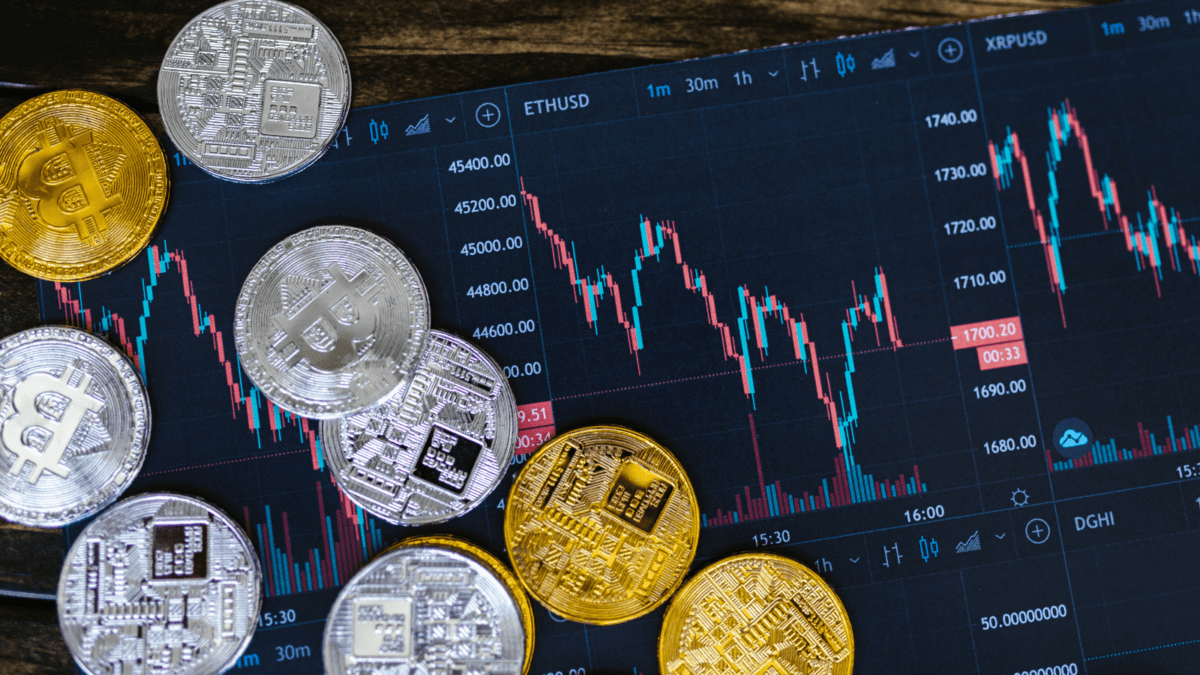What are Stablecoins and how do they work?
Stablecoins are one type of cryptocurrency that is designed to maintain a fixed value over time. The value of a stablecoin is typically pegged to another asset class such as fiat currencies or precious metals. In this setup, one unit of the cryptocurrency typically equals one unit of the real currency.
Unlike highly volatile cryptocurrencies such as Bitcoin and Ethereum, the price of stablecoins is not meant to fluctuate. Because they are price-stable digital assets that act somewhat like fiat but maintain the versatility and utility of cryptocurrencies, stablecoins are an innovative solution to crypto volatility.
The different stablecoin categories are in essence indicative of the assets backing them. There are four primary stablecoin types, identifiable by one of four underlying collateral structures: fiat-backed, crypto-backed, commodity-backed, and algorithmic. While underlying collateral structures can vary, stablecoins always aim for the same goal: stability. Let’s dive into the four primary types of stablecoins.
1. Fiat-collateralized Stablecoins
Fiat-collateralized stablecoins are pegged to real-world currencies, such as the Euro, GBP, or USD at a 1:1 ratio backing. Each stablecoin should be backed up by a real unit of fiat currency locked away in reserve as collateral.
Fiat collateral must remain proportional to the number of stablecoin tokens in circulation and generally stays in reserve with a central issuer or institution. For example, if an issuer has $50 million of fiat currency, it can only distribute 50 million stablecoins, each worth $1.
Users can redeem their coins as the institution managing the stablecoin takes the proportional amount of fiat currency from their reserve and transfers it to the user’s account. Consequently, the equivalent amount of stablecoins is taken out of circulation or destroyed.
Fiat-backed stablecoin is the most straightforward stablecoin category due to its structural advantage. Thus, fiat-backed stablecoins could play a huge role in encouraging the large-scale adoption of stablecoins. Popular examples of fiat-collateralized stablecoins include Tether (USDT), True USD (TUSD), Binance USD (BUSD), and Paxos Standard (PAX).
2. Commodity-backed Stablecoins
Commodity-backed stablecoins are collateralized using physical assets such as precious metals, oil, and real estate. The most popular commodity used as collateral is gold. The commodities generally offer a chance for appreciation in value over the course of time. As a result, commodity-backed stablecoins tend to offer better incentives for investors holding. However, it is important to note that these commodities can, and are more likely to, fluctuate in price and therefore have the potential to lose value.
One example of a commodity-backed stablecoin is Digix Gold (DGX). It is essentially an ERC-20 token developed on the Ethereum network and backed by physical gold. DGX is the perfect example of a commodity-backed stablecoin by pegging one DGX to one gram of gold. Tether gold (XAUT) is another example; the token is backed by a reserve of gold stored in a vault in Switzerland. One ounce of gold is equal to one XAUT.
3. Crypto-backed Stablecoins
Crypto-backed stablecoins are backed by other cryptocurrencies and are usually over-collateralized to buffer against market volatility. For example, if you want to buy $100 worth of a certain stablecoin, you would need to deposit $200 worth of x coin – this equates to a 200% collateralized ratio. Therefore, if there is a sudden market drop, the value of the stablecoin bought can still be covered. If the price of the collateralized crypto drops enough, the stablecoin will be automatically liquidated.
Users lock away their crypto into a smart contract to acquire tokens of equal proportional value when buying crypto-backed stablecoins. They can withdraw the original collateral amount after putting their stablecoin back into the same smart contract.
One of the most popular crypto-backed stablecoins, MarkerDAO, makes use of this mechanism. This is realized by utilizing a collateralized debt position (CDP) via MakerDAO to secure assets as collateral on the blockchain. It uses a smart contract alongside the Ethereum blockchain to pool enough ETH to use as collateral for its stablecoin. Once the amount of collateral reaches a certain level in the smart contract, users can mint DAI – the MakerDAO stablecoin.
These assets are less stable than fiat-backed stablecoins, and it is a good idea to keep an eye on how the underlying crypto asset is performing. Crypto-collateralized stablecoins do offer better decentralization in comparison to fiat-collateralized stablecoins. Such stablecoins help processes become more trustless with improved security and better transparency. Certain crypto-backed stablecoins also have the backing of multiple cryptocurrencies to ensure efficient risk distribution.
4. Algorithmic Stablecoins
Algorithmic stablecoins do not use any fiat, crypto, or assets as collateral. Rather, specialized algorithms and smart contracts are used to control the supply of tokens in circulation so that the price remains stable. Algorithmic stablecoin systems by design will decrease the number of tokens in circulation when the market price falls below the price of the fiat currency it tracks.
Alternatively, if the price of the token exceeds the price of the fiat currency it tracks, new tokens come into circulation to adjust the stablecoin value downward. In short, these algorithms automatically burn or mint new tokens based on the fluctuating demand for the stablecoin at any given time.
Since there is no collateral involved and algorithmic coins are not sufficiently backed by hard assets, it could suffer a run and lose the peg against its target currency. That’s effectively what happened to TerraUSD (UST) as of recent. The price of the stablecoin broke and crashed in a death spiral, as traders lost confidence in its ability to maintain the peg.
What happened to Terra Luna?
The rapid collapse of Luna sent a ripple effect across the crypto market and stands as an important lesson in the systemic risks of algorithmic stablecoins.
Luna is the token that powers Terra’s protocol. Its primary purpose is to provide liquidity for trades and keep the price of UST stable. Users can stake their tokens to provide liquidity for traders and earn rewards. The Terra protocol also uses this liquidity to maintain the UST price at a steady $1.
When the price of UST falls below $1, Luna is created and UST is burned. This increases the amount of Luna for every UST and inflates the price of UST. Conversely, when UST rises above $1, Luna is burned and UST is created. This decreases the amount of Luna for every UST and lowers the price of UST. However, this system failed last week and made the price of UST drop below $0.20 of its $1 peg.
It worked, until it didn’t.
In the first few weeks of May 2022, some large UST withdrawals were made. Certain ‘whales’ allegedly dumped large amounts of both BTC and UST on the market causing a liquidation cascade of leveraged longs, slippage and panic selling by investors, many of which sold their Luna holdings and unstaked their UST to sell it. The UST sales increased the supply and brought the price of UST down.
When the price dipped below $1, many panicked and sold. This drove the price down even further. To counter this, Terra began burning UST and minting Luna tokens. However, its system had a maximum amount of UST that could be burned. Once that limit was reached, the stablecoin began to freefall.
Regarding Luna, as UST fell, many also exited their Luna positions. This is because UST is an integral part of Terra’s protocol, so its failure could mean dire things for Luna. So, Luna’s price began to freefall due to the selloff of UST. Luna’s supply was also increasing abruptly in an attempt to keep the price of UST stable. This further decreased the value of Luna as greater supply means selling pressure.
In the past week, Luna has fallen from nearly $90 USD to pretty much $0. Investors holding Luna lost their entire position.
Why did we need stablecoins in the first place?
Stablecoins solve one of the leading problems with most mainstream cryptocurrencies, that is, their drastic price fluctuations make it tough, if not impossible, to price things and use them for real transactions. Stablecoins are inherently built to keep their prices stable, not shoot up in value. The USD coin, for instance, has barely drifted from its $1 value for its entire existence. Stablecoins are supposedly a form of digital cash rather than a speculative investment.
The interest in stablecoins is that they are built to withstand volatility in a way that other cryptocurrencies aren’t, but still offer accessibility and utility. A more stable cryptocurrency is still decentralized. That provides a door opener into the world of DeFi, with possibilities including faster money transfers, access to financial services without applications, keeping data private, and avoiding financial service fees.
Some stablecoins can also be used for crypto staking, where investors earn rewards by virtually lending out their holdings to help execute other transactions. Additionally, their stability allows many stablecoins to be used as a functional currency within a crypto exchange. For example, traders might convert Ethereum into a stablecoin such as USDT, rather than into USD.
Bottom Line
The different stablecoin types clearly showcase the various ways in which stablecoins could operate. At present, stablecoins are working with four clear-cut models which follow different collateral structures. Each stablecoin category has its distinct characteristic, i.e., the collateral for backing the stablecoin. There are other low-key differences you can take note of. For instance, crypto-backed stablecoins are more liquid, while fiat-backed stablecoins are easier to grasp and use for beginners.








